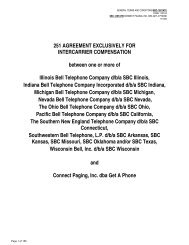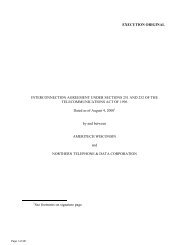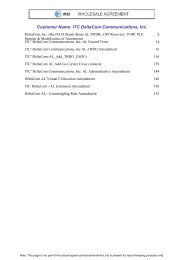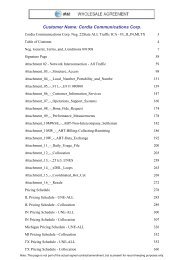Optical Telecommunications, Inc.
Optical Telecommunications, Inc.
Optical Telecommunications, Inc.
Create successful ePaper yourself
Turn your PDF publications into a flip-book with our unique Google optimized e-Paper software.
Version: 2Q05 Standard ICA<br />
07/06/05<br />
Attachment 3<br />
Page 9<br />
4.10.2 BellSouth Access Tandem Interconnection. BellSouth Access Tandem<br />
interconnection at a single Access Tandem provides access to those End Offices<br />
subtending that access tandem (Intratandem Access). Access Tandem<br />
interconnection is available for any of the following access tandem architectures:<br />
4.10.2.1 Basic Architecture. In the basic architecture, OTI’s originating Local Traffic, ISP-<br />
Bound Traffic and IntraLATA Toll Traffic and originating and terminating Transit<br />
Traffic is transported on a single two-way trunk group between OTI and BellSouth<br />
Access Tandem(s) within a LATA to provide Intratandem Access. This trunk<br />
group carries Transit Traffic between OTI and ICOs, IXCs, other CLECs, CMRS<br />
providers that have a Meet Point Billing (MPB) arrangement with BellSouth, and<br />
other network providers with which OTI desires to exchange traffic. This trunk<br />
group also carries OTI originated Transit Traffic transiting a single BellSouth<br />
Access Tandem destined to third party tandems such as an ICO tandem or other<br />
CLEC tandem. BellSouth originated Local Traffic, ISP-Bound Traffic and<br />
IntraLATA Toll Traffic is transported on a separate single one-way trunk group<br />
terminating to OTI. The LERG contains current routing and tandem serving<br />
arrangements. The basic Architecture is illustrated in Exhibit B.<br />
4.10.2.2 One-Way Trunk Group Architecture. In one-way trunk group architecture, the<br />
Parties interconnect using three (3) separate trunk groups. A one-way trunk group<br />
provides Intratandem Access for OTI-originated Local Traffic, ISP-Bound Traffic<br />
and IntraLATA Toll Traffic destined for BellSouth End Users. A second one-way<br />
trunk group carries BellSouth-originated Local Traffic, ISP-Bound Traffic and<br />
IntraLATA Toll Traffic destined for OTI End Users. A two-way trunk group<br />
provides Intratandem Access for OTI’s originating and terminating Transit Traffic.<br />
This trunk group carries Transit Traffic between OTI and ICOs, IXCs, other<br />
CLECs, CMRS providers that have a MPB arrangement with BellSouth, and other<br />
network providers with which OTI exchanges traffic. This trunk group also<br />
carries OTI originated Transit Traffic transiting a single BellSouth Access Tandem<br />
destined to third party tandems such as an ICO tandem or other CLEC tandem.<br />
BellSouth originated Local Traffic, ISP-Bound Traffic and IntraLATA Toll Traffic<br />
is transported on a separate single one-way trunk group terminating to OTI. The<br />
LERG contains current routing and tandem serving arrangements. The one-way<br />
trunk group architecture is illustrated in Exhibit C.<br />
4.10.2.3 Two-Way Trunk Group Architecture. The two-way trunk group Architecture<br />
establishes one (1) two-way trunk group to provide Intratandem Access for the<br />
exchange of Local Traffic, ISP-Bound Traffic and IntraLATA Toll Traffic between<br />
OTI and BellSouth. In addition, a separate two-way transit trunk group must be<br />
established for OTI’s originating and terminating Transit Traffic. This trunk group<br />
carries Transit Traffic between OTI and ICOs, IXCs, other CLECs, CMRS<br />
providers that have a MPB arrangement with BellSouth, and other network<br />
providers with which OTI exchanges traffic. This trunk group also carries OTI<br />
originated Transit Traffic transiting a single BellSouth Access Tandem destined to<br />
CCCS 110 of 261
















